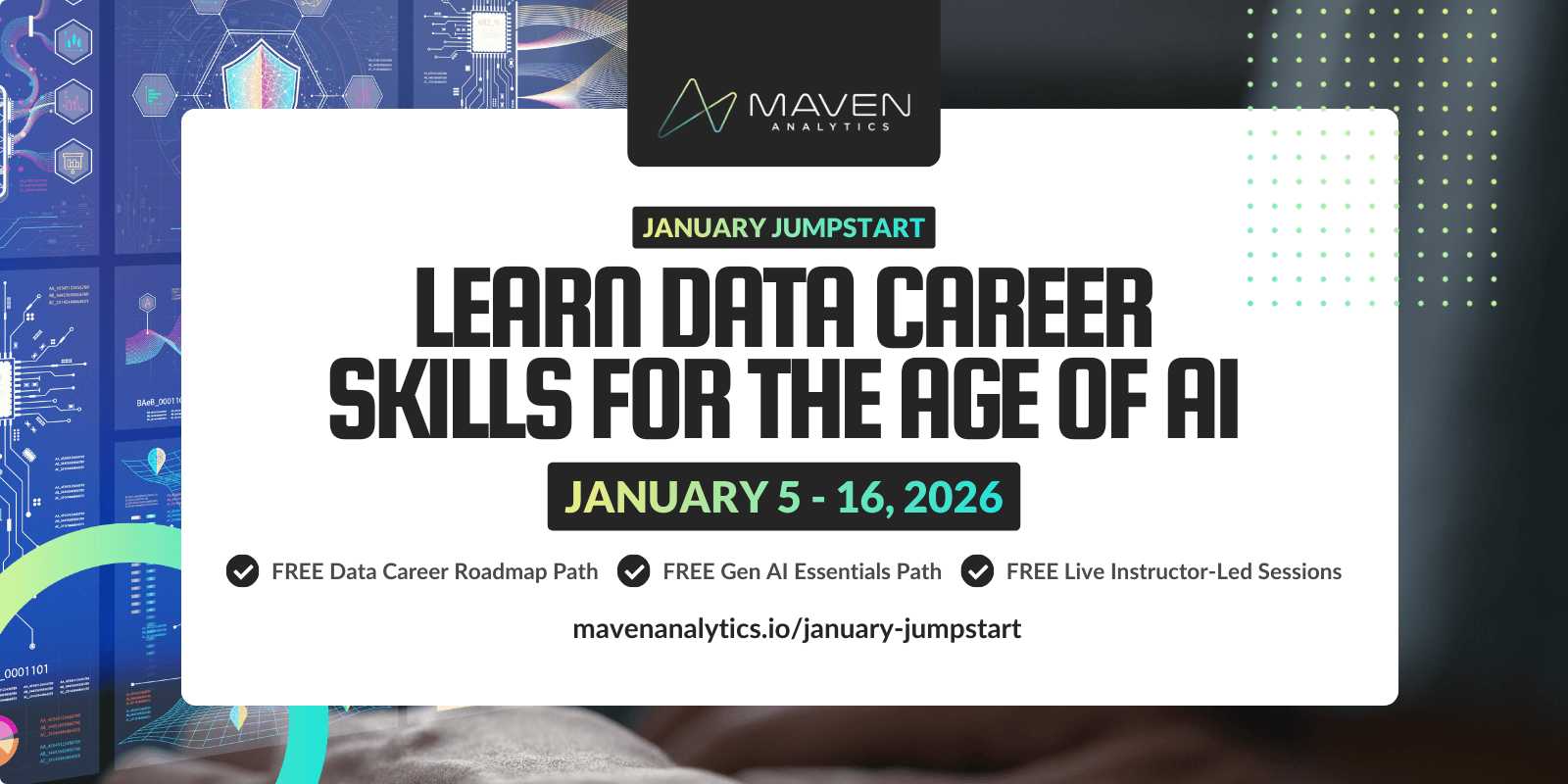Hi everyone, I’m excited to be joining the Maven team as their first Python instructor. I’m looking forward to bringing you a series of courses designed to help data professionals add Python to their analytics toolkit.
Our first course, Python Foundations, will be launching in just a couple of weeks.
I want to introduce myself to you all, and share the steps that led me to Maven. Let's dive in.
A Carpenter Without Tools.
Like many data professionals, I didn’t go to university envisioning myself in a job where I’d be coding daily. I went to school with a love of economics and a desire to one day help organizations make better decisions. Of course, it seems silly in retrospect, but I loaded up on math, statistics, and economic theory, while ignoring just about any course that would have given me marketable technical skills.
I had learned point and click software that could help me build an econometric model for my classes, but that were mostly confined to Academia. I was a good problem solver, but outside of rudimentary Excel learned on the fly, I had very few marketable technical skills.
Given the lack of tools, I was fortunate to land a job in supply chain management, where I spent entire days (and late nights) forcing my way through problems that would take a skilled Excel professional an hour or two, slowly getting more efficient as I learned what I could on the fly.
Back to School
After a few years of that, I knew I needed to step up my technical skills and decided to enroll in NC State’s Masters of Analytics program. I finally gained the technical skills I needed, while further beefing up on applied statistical and machine learning techniques.
I was able to land a job at Liberty Mutual Insurance in Boston, leveraging the tools and techniques that I’d learned into a Data Scientist role. The day I got my offer was one of the best days of my life – I’d done it, and now I could sit back and be the problem solver I set out to be.
I had the opportunity to work in customer service analytics, where we focused on implementing machine learning solutions to improve call center efficiency that didn’t decrease customer satisfaction. Most of my time was spent as an analyst – identifying opportunities, building data pipelines, and providing insight into the performance of our projects. A few times a year I’d put on my data scientist hat and build or refit some models, but in many ways, I enjoyed my analyst work more than the model fitting.
I also had the fortune of being selected to a corporate team to help build internal SAS and statistical coursework for the company, designed to help interns and new hires quickly learn the skills they needed to succeed – this was my first taste of building courses, and I loved it.
Getting Complacent
Around the same time, open-source programming languages like Python were rapidly adding new capabilities, leveraging an ever-growing community to implement algorithms more quickly than tools like SAS or Excel ever could. More and more job postings were listing Python as a required skill, while fewer were mentioning SAS. The writing was on the wall: I needed to learn Python.
Initially, I tried to learn Python the easy way – borrowing the code of colleagues or copying it from blogs, stitched together with a few lines of my own just to get past whatever hurdle I could. This worked to an extent, but I found myself brute forcing my way through problems and writing messy code that I cringe to look at now. In other words, I was at the same point I was at when I’d gone back to school for my Masters – brute forcing my way through problems that should have been trivial, except this time around going back to school wasn’t an option. I’d have to build a program for myself.
Back to basics
I finally got serious and focused on learning the fundamentals of the Python language. I bought several textbooks and signed up for a few online courses. These varied significantly in quality, but I was learning. Every basic concept I learned allowed me to go back and find ways to improve my code, while making new projects significantly easier to tackle. My performance improved, and I eventually found myself loaning my code out to colleagues, which felt great.
Once I had mastered the foundations of Python, I found myself easily able to learn new high-powered tools to enhance the power of Python, like Spark, which allowed me to build lightning-fast fraud detection models at Verisk Analytics, where we were able to identify medical providers taking advantage of complex medical billing codes to overcharge significantly for simple services, in some cases recouping millions from individual doctors.
Supercharging Student Success
Being able to build models that had a positive impact on society was very rewarding, but I still found myself looking for something more – I just didn’t know what it was. Around the same time, I followed my partner to San Francisco, where she’d taken a job at an exciting company. I quit my role and took a few months to look for a new one.
I was contacted by Metis, a data science bootcamp, about joining their team as an instructor. Immediately I realized this might be the role for me. I had always thought teaching might be a second career once I’d seen my analytics career through, but now I was presented with an opportunity to keep my tech salary while teaching the topics I loved.
Unfortunately, another strong candidate was further along in the process, and they needed an instructor confirmed immediately for the upcoming cohort. I didn’t get the role, and I was crushed. They did mention they thought I had the potential to be a Rockstar, which was flattering, and to keep me in their orbit they offered me part-time work developing online Python courses.
After a few months of this, I started looking for full-time roles. I interviewed with a few companies and eventually received an offer for a Data Scientist role at Facebook. By coincidence, an instructor position opened at Metis, and the next day I received an offer for that role. I was now faced with a choice between returning to the corporate environment I’d built my career on, at a high growth tech company, or trying something completely different – teaching full-time. Do I choose the safe choice or the option that would allow me to help others change their lives? After a few days of deliberation, I chose to follow my heart and become an instructor.
Having to ‘relearn’ Python from the beginning has equipped me with a unique perspective on learning the language that I was able to refine during a few years of teaching these concepts in data science bootcamps.
I hadn’t heard of Maven when Chris Dutton reached out to discuss joining the team, but it only took me an hour of reviewing the Maven Platform to be blown away by the quality and depth of the course content. I’d taken many online courses, but few approached the depth of Maven’s coursework, and none with practical projects that weren’t derived from the typical rehashed datasets.
To be honest, I was almost intimidated by the quality of Maven’s courses – I’d taught Python courses many times, but could I create them from scratch and deliver them at the level Maven’s instructors could? I wasn’t sure – but I knew I’d regret not taking on the challenge. After a few months in stealth mode working on Maven’s first coursework – I’ve learned a ton from the instructors here, and I’m excited to share what Python + Maven looks like.
If you’ve tried and failed to learn Python or have been curious but never taken the plunge – I’d be honored for you to join me as we tackle these concepts together. It’ll take patience, perseverance and practice, but I’m positive you too can become an analyst powered by Python.
Happy learning!-Chris
Happening NOW: Free Course Access + LIVE Learning
January Jumpstart is here -- don't miss this chance to kickstart your new year!
Join us January 5th - 16th to jumpstart the new year with LIVE instructor-led learning sessions and FREE course access to our top career & AI learning paths. Let’s make AI your new data superpower in 2026!

Chris Bruehl
Analytics Engineer & Lead Python Instructor
Chris is a Python expert, certified Statistical Business Analyst, and seasoned Data Scientist, having held senior-level roles at large insurance firms and financial service companies. He earned a Masters in Analytics at NC State's Institute for Advanced Analytics, where he founded the IAA Python Programming club.










































